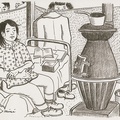Part 1 >>
Grant Jiro Hirabayashi
Grant Jiro Hirabayashi was born in November 1919. He was named after the Rev. Ulysses Grant Murphy, a Methodist minister and former missionary to Japan who befriended the Mukyokai group. Grant’s father, Toshiharu, was considered the most knowledgeable among the Mukyokai fellowship, since he had attended academy in Hotaka longer than any of the others. Grant’s early religious exposure came from his family setting: “My parents made sure we went to church. I had at least three Bibles for perfect attendance so there was something passed on; the twelve years I spent here left a strong impression.”21
Grant’s desire to visit Japan was sparked by two of his boyhood friends. They had gone to Japan during summer vacation, making Grant envious of their experience and knowledge: “I heard Kenji and Tom talking about their visit to Japan. My gosh, I’d better learn more about Japan, in order to stay with the crowd.” Grant’s father told him that since he was one of eight children, he couldn’t afford to send him just for a vacation. But if he would stay and study for two years, he would send him: “I had to make that commitment, which I readily accepted.” In 1932, at the age of thirteen, Grant was sent to live with his father’s eldest brother.
In school, the teachers were sympathetic, allowing him to wear Western clothing and keep his hair long. After a year, however, in order to conform, he switched to wearing zori (sandals) and had his hair styled in a crew cut. His peers generally accepted him. Being fast on his feet, he made the track team, and with his ability to help fellow students with their English, he was able to gain some popularity among his peers. His teachers appointed him “moral officer” of the class. 22
During these school years he took mandatory military training classes: “For some reason the officer favored me, so I was one of the commanders of the school.” After three years, Grant was ready to return home, but was told by his father to finish high school. He remained in Japan for a total of eight years, not returning home until 1940.
Although Grant tried to conform to the ways of his peers, he realized that he was somewhat different and never thought of himself as a Japanese: “Noooo, I considered myself an American.” This distinction was reinforced at times, such as when all of the moral officers were sent to Tokyo to represent the school and he was not selected to accompany them. “And then I said to myself, oh I’m not a citizen. I knew I was different and, of course, I always felt like an American for some reason.” They wanted to recommend him for officer’s training school, but he declined: “I said thank you but no thank you because I am an American.” In spite of eight years of Japanese education, Grant’s self-identity did not change:
I’m not sure I was influenced and brainwashed to some extent, but still I identified myself as American. I know what my friends in Japan are being exposed to and I know how they think, I have strong feelings for them, but as far as my experiences, at no time did I hesitate as far as my loyalties were concerned. I think, twelve years however short, for some reason – my parents and Christianity, the upbringing was such that I always associated myself here.
Although he was exposed to various religious beliefs in Japan, Grant had no inner conflicts because of it. “To me, I didn’t see anything wrong with Buddhism, Shintoism, Confucianism – I like Confucianism – and Christianity and the Ten Commandments. I think they all share – have things in common.” And while he was in Japan “there was no one telling me that you can’t believe in Christianity.” He still considers himself a practicing Christian.
After Grant was in Japan for eight years, his brother Martin, who had a scholarship to study the Japanese language at Kyoto University after graduating from the University of Washington, “told me to go home because the political situation – the international relations between the two countries was deteriorating.” Returning home in 1940, “I was told at Kent High School, you can get credit for work done in Japan, so I finished high school in one year.” He found work in a local garage operated by an Issei. But that lasted only a few months: “I enlisted in the Army Air Corps after being inducted into the army. My thinking then was that war was inevitable and that if I am going to serve in the army, I wanted to pick up a trade, and what I had in mind was to become an airplane mechanic.” He was sent to Fort Lewis, Washington.
Within a few days the war began, and Grant was immediately sent to Jefferson Barracks in Missouri. “All of the Nisei were placed into ‘protected custody’ and confined to barracks for forty days. During that period we were marched to the mess hall, marched to the PX, no recreation. There were about thirty of us Nisei.” After basic training in June 1942, all assignments for Japanese Americans serving the Army Air Corps stationed at Jefferson Barracks were terminated, and they were reassigned. Grant was sent to Fort Leavenworth to work in a hospital during the summer of 1942.
Soon Grant received a letter from Col. Kai Rasmussen “asking me for my history and experience, and before I knew it, I received orders to report to the Military Intelligence Service Language School, Camp Savage, Minnesota.” He trained to become a translator and interrogator. 23
While at Camp Savage, Grant obtained leave and traveled by train to the Tule Lake camp to visit his parents, who had been incarcerated there since late summer 1942. He was surprised and shocked by the conditions he saw:
When I got to the desert, and finally arrived at Tule Lake, a desolated area with barbed wire, watch dogs, and guards that were facing not out, facing inside, I’m sure that they {parents} were quite depressed, yeah, but they were happy to see me. After a brief visit I left, and that was quite depressing. I got on the train and was totally devastated.
The army relocated the Military Intelligence Service Language School to Fort Snelling, Minnesota, in 1944. While awaiting assignment, a call went out for volunteers for a “dangerous” mission. Two hundred volunteers stepped forward, and Grant was among the fourteen selected. They were sent to India, where his unit received jungle training. Subsequently the unit was designated as 5307 Provisional Unit, with Brig. Gen. Frank D. Merrill as commander. They later became well known as “Merrill’s Marauders.”
During their first encounter in Burma with soldiers of the Japanese Army in early September 1944, they came upon scattered food supplies. Among them was a torn miso bag labeled “Shinshu Miso,” produced in the region where Grant had lived: “I didn’t want to meet any of my classmates, but fortunately the unit we fought was from Kyushu in southern Japan.”
Among his duties was interrogating POWs. He developed a standard procedure for interrogating them:
I asked him if he was wounded, sick, or if he needed medical attention. And then I said, where you from? Your parents, have you heard from them lately? And while conversing with him, I smoked a cigarette with him and of course, his attitude changed and actually a tear came down and taken by surprise, he said: “You’re aren’t going to shoot me?” Ah no, I won’t shoot. And so he became very cooperative.
Once, however, an officer who was taken prisoner challenged him: “’You’re a traitor.’ I said I’m an American. He called me a traitor and refused to answer my questions. I was quite disappointed when he called me a traitor. Subsequently, however, he became cooperative.”
After the war Grant served with the occupying forces in Japan from 1947 to 1951. He worked there for the supreme commander for the Allied Powers (SCAP) as an interpreter, translator, and interrogator during the war crimes trials. Whether he was serving the prosecution or the defense, he wanted to be truthful and fair: “I always wanted to help as much as possible. As a matter of fact, I had many lawyers from the defense coming to me because they felt I was more understanding.” And, after all his years in Japan, he did strongly empathize with the Japanese: “Well, I just go by the facts, whether one is on the defense or prosecution. I could feel for the Japanese. I know how they felt.” In his mind, however, his loyalties were never in question:
Although there were many things which I didn’t like about America because of discrimination, at no time did I hesitate as far as my loyalties were concerned. I knew I was an American and couldn’t be anything else.
After his work with the war crimes trails, Grant returned to the United States and went to college on the G.I. bill. He attended the University of Southern California, where he received his bachelor’s and master’s degrees in International Relations. He subsequently worked for the Department of State, the Library of Congress, and the Department of Defense. He is now retired and as of 2002 lives in Spring, Maryland.
Notes:
I would like to thank Ako Wooley for her translations of Issei writing; Louis Fiset, Gail Nomura, and Lane Hirabayashi for insightful feedback; and the four cousins, Grant, Gordon, Bob, and Hank, for sharing their lives with the community. The author is a member of the Hirabayashi kin group and the younger brother of Gordon Hirabayashi.
21. The following vignettes on the cousins are based on interviews conducted by the author in 1996. When quoting from these interviews, the interviewee’s name will always precede the quotes, and citations will not be made after the quotes.
22. Kofukai yakunin , a person in charge of upholding the school traditions or morals, the esprit de corps of the class.
23. For the role of Japanese Americans in American military intelligence, see Joseph D. Harrington, Yankee Samurai: The Secret Role of Nisei in America’s Pacific Victory (Detroit: Pettigrew Enterprises, 1979), and Tad Ichinokuchi, ed., John Aiso and the M.I.S., Japanese American soldiers in the Military Intelligence Service, World War II (Los Angeles: Military Intelligence Service Club of Southern California, 1988).
* This article was originally published in Nikkei in the Pacific Northwest: Japanese Americans & Japanese Canadians in the Twentieth Century , edited by Louis Fiset and Gail M. Nomura (University of Washington Press, 2005) and reprinted with permission.
** In preparation of the Enduring Communities National Conference (July 3-6, 2008 in Denver, CO), we are posting an essay by James Hirabayashi that was originally published in the book, Nikkei in the Pacific Northwest: Japanese Americans and Japanese Canadians in the Twentieth Century. James Hirabayashi will present a dramatic reading about these four cousins at the National Conference titled, "Four Hirabayashi Cousins: A Question of Identity on July 3 and 4, 2008." Enduring Communities is a project of the Japanese American National Museum.
© 2005 James A. Hirabayashi






